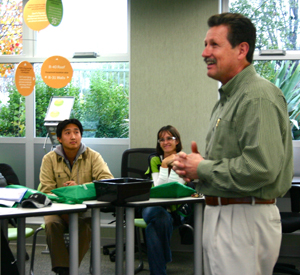Environmental Curriculum Launches in California Districts
MANTECA, Calif. — In the fall of 2010, California became the first state to launch the Education and Environment Initiative, a program that provides 85 units of environment-based curriculum in the form of teacher textbooks, lessons and online materials.
 “This first-in-the-nation environmental curriculum will help change the way we look at solving our environmental problems and is designed to help prepare today’s students to become future scientists, economists, and green technology leaders,” according to American Modular Systems, a sponsor of the program.
“This first-in-the-nation environmental curriculum will help change the way we look at solving our environmental problems and is designed to help prepare today’s students to become future scientists, economists, and green technology leaders,” according to American Modular Systems, a sponsor of the program.Nineteen districts pilot tested the program throughout California and are now in the final implementation stage, said Lindsay Vanlaningham, deputy secretary for communications and external affairs at the California EPA.
Currently, two school districts are implementing the program, which is available to grades K-12 but can be limited to just a few, she said.
The city of Manteca was the first district to implement the curriculum, with training for teachers beginning in December.
The district had developed some of its own coursework on environmental stewardship, but was looking for ways to enhance the current program.
“We’d looked at a number of different curricula,” said Victoria Brunn, Energy Education Specialist and the Sustainability Coordinator for the Manteca Unified School District’s Leadership on Green Initiatives Committee. “We felt EEI was the strongest. The curriculum looks at environmental issues from a global perspective.”
The Manteca Unified School District currently has implemented the curriculum in 19 of its schools and trained 23 teachers in the district, Brunn said.
The initiative provides a series of units per grade level, with student and teacher workbooks for each unit, that pertain to energy, recycling and conservation projects, among others.
“I think one obstacle is just trying to find the time to cover everything we want to do because it is such rich curriculum,” Brunn said. “Although, these are matched up to state curriculums, and that’s what makes it different from other curriculums.”
Training for teachers in the Manteca District was funded by locally based American Modular Systems, who manufactures Gen7, high performance, and green classrooms.
The agency is currently trying to create public-private partnerships to help fund further training and printed materials for use, Vanlaningham said.
Brunn encouraged school districts to reach out to learn about the initiative.
“I think it’s really critical to look at what type of construction is going on in the district and match it up so we’re having green construction for green students, so to speak,” she said.
The Santa Monica-Malibu School District also launched the program at the beginning of the month.
“Santa Monica-Malibu Unified School District teachers are excited to be some of the first in the state to implement this curriculum with assistance from the Sempra Energy Foundation,” said District representative Bertha Roman. “This validates the commitment from the Santa Monica-Malibu community to provide an environment-based education to provide students with up-to-date lessons and information.”
The curriculum comes at a time when there is five-year moratorium on the adoption of new textbooks in the state, making the EEI curriculum the only new State Board of Education approved instructional materials available to students for years to come, according to a statement from the California EPA.
Jack O’Connell, Superintendent of Public Instruction, California Department of Education, expressed his support for the initiative.
“Students today will be responsible for making the decision that influence the health of the world in which we live,” he said. “The EEI curriculum provides the foundation to prepare students to be informed, environmentally conscious, decision makers.”
The initiative was a collaborative effort led by the California Environmental Protection Agency, with the support of many public and private organizations.
